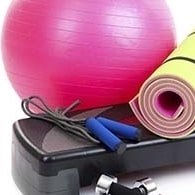Back Stretching Exercises
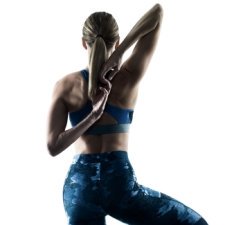
This series of back stretching exercises will stretch the lower and upper back. Stretching your back muscles help keep it healthy and strong.
Back stretches are one of the best ways to help protect the back and prevent back injuries.
With the everyday activities we do the back muscles tighten up and can cause back pain and potential injury. This is more prevalent as we age.
We’ve all probably had a time or two where we lifted something and felt the stabbing pain in our lower back or woke up one morning feeling stiff and sore in the back.
Keeping your back muscles stretched and loose can help alleviate the back pain and soreness. There are six different stretches with step by step instructions to ensure you are doing them correctly.
List of Back Stretching Exercises
- Lower Back Stretches
These include Knee Drop, Spinal Twist, Seated Twist, Child Pose and Cat/Cow Pose. - Upper Back Stretches
These include the Reach Out Stretch, Reach Up Stretch and Upper Trapezius Stretch.
Anatomy of the Back Muscles
The muscles of the back are divided into two specific groups. These are the extrinsic muscles and the intrinsic muscles.
The extrinsic group is associated with the upper extremities and shoulder movement while the intrinsic muscles help to maintain your posture and move the vertebral column.
Extrinsic Group
In this group of back muscles, you have superficial muscles and intermediate muscles. The superficial layer is the
v-shape area associated with the upper and middle back.
They connect the upper extremities to your trunk. This superficial layer includes the trapezius, latissimus dorsi, levator scapulae and the rhomboids.
The intermediate layer includes the serratus posterior, superior and inferior. Their primary function is involved with respiration.
When thinking in terms of upper back stretching exercises, it is the superficial layer that you are stretching.
Intrinsic Group This group of muscles stretch all the way from the pelvic to your head. The intrinsics group is divided into three different groups; the superficial layer, the intermediate layer and the deep layer of muscles.
The superficial layer consists of splenius capitis and splenius cervicis muscles. These muscles laterally flex, rotate and extend your head and neck.
The intermediate layer are the erector spinae muscles and are the muscles you think of when talking about lower back stretches. These lay on either side of the vertebral column and their primary job is to extend the vertebral column and maintain proper posture.
The deep layer of muscles in the intrinsic group include semispinalis muscles, multifidus muscles and the rotatores muscles.
While the names and functions of these muscles can be a bit complicated, keeping your back strong does not have to be. Be sure to do strengthening and stretching exercises to maintain a healthy back.
Lower Back Stretching Exercises
These lower back stretches help with back pain issues. In addition to targeting the lower back muscles, these back stretching exercises will also stretch your side abdominal muscles, the obliques, and your hips. Tight core muscles are often associated with lower back pain. Your core is made up of three major areas of the body. These are your lower to mid back area, the abdominals and side abdominals and the hip region.
The major abdominal muscles which make up their part of the core are the rectus abdominis, external and internal obliques and the transverse abdmoninis. Hip area includes the hip flexors, abductors (the outer part of the thigh) and the adductors (the inner part of the thigh). Lastly, the back muscles that are part of your core include the erector spinae, pelvic floor muscles and the latissimus dorsi (or your lats).
Stretching the lower back can reduce tension in the muscles. Tense muscles can worsen back pain. There are several step by step instructions for different stretches of the lower back.

Knee Drop Stretch
- Lie on the mat with your back flat on the mat and knees bent with your feet on the floor.
- Place your arms straight out to your sides for stability.
- Keeping your knees together, drop them down to one side. Your knees don't have to touch the ground. Just go as far as you can to feel the stretch in the lower back.
- Hold in this position for a count of 10 or so. Then repeat on the other side. Do several reps.
Stay on your mat for this next stretch. For this one, the starting position is almost the same as the first back stretching exercise.

Spinal Twist Stretch
- Lie on the mat with your back flat and one leg straight and one leg bent (with that foot on the floor).
- Drop the one knee down across the leg that is straight and to the floor. So if your left leg is straight, the right leg (bent at the knee) will drop to the left side causing a twist in the spine.
- Keep your head straight looking up to the ceiling.
- Hold this for a count of 10 or so and repeat for the other side.
Remember not to over stretch. If you start to feel pain and discomfort, try not twisting as far. If you need to, bend the leg slightly instead of fully straight.

Seated Twist
- Sitting on the mat, extend one leg out on the ground with knee straight.
- Take your other leg and cross it over the body, bending your knee and placing your foot on the ground.
- Now twist your body towards the bent knee placing your elbow on the knee. Your other hand should be on the mat for stability.
- Deepen the twist to really feel the stretch up the back.
- Hold for 20 seconds or so and repeat for the other side.
This is one of my favorite back stretching exercises. I can really feel the stretching of the muscles with this one.
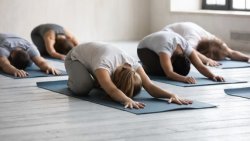
Yoga Child Pose
- Kneel down on the mat and sit back on your heels.
- Reach your arms in front of you placing your hands, palms down, on the mat.
- Slowly drop your head and place your forehead on the mat. Your back should be rounded at this point.
- Hold this stretch and remember to breath.
Yoga poses are perfect for stretching the back and other muscles in your body.
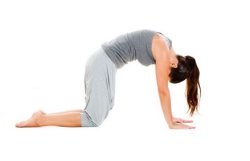
Yoga Cat / Cow Pose
- Start on the mat on your hands and knees with arms about shoulder width and knees hip width apart. Your back should be straight (to form a tabletop).
- As you exhale out, round your back dropping your head down to get the full back stretch. This is the cat pose.
- Hold in this position for 10 seconds or so.
- Release that stretch and go in the opposite direction arching your back and lifting your head up towards the ceiling. This is the cow pose.
- Hold this for 10 seconds or so.
- Keep alternating this stretch.
If you want you can just do the cat pose several times then switch to the cow pose. When doing only one pose, just return to the tabletop position between each stretch.
Upper Back Stretching Exercises
Although most back pain is in the lower area, keeping the upper back muscles stretched is just as important to minimize risk of injury. The upper back region is also known as the thoratic spine region. There are several different muscles that make up this region.
The largest of these is the Trapezius, better known as the "traps". The trapezius is a flat, triangular shaped muscle. It covers the thorax, shoulders and back of the neck. Other smaller muscles of the upper back include the Infraspinatus muscle, the Teres major and minor muscles and the scapula (shoulder blades).
The Deltoid muscles are your shoulder which are attached to the shoulder blades. So when stretching your upper back, you will often also be stretching the Deltoids.
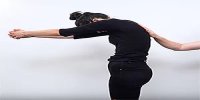
Reach Out Stretch
- Stand with legs at hip width.
- Stretch your arms out in front of you with palms facing down or grasping hands together.
- Push your hands forward as far as possible.
- Let your head fall forward between your arms.
- Hold this for 20 seconds or so.
This upper back stretching exercise is ideal for those who have tight muscles between the shoulder blades. Tightness can be caused by too much lifting or poor posture.

Reach Up Stretch
- Stand straight with legs slightly apart.
- Stretch your arms out in front and interlace your fingers palms facing out.
- Bring your arms straight up and reach out above you.
- Push back as far as you can and reach up as high as you can and stretch. Be sure to keep your head up.
- Hold this for 20 seconds or so.
Be sure to wear comfortable fitting clothing when doing any stretching exercises.
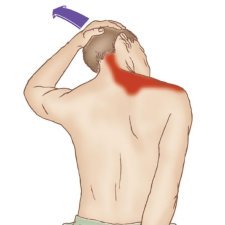
Upper Trapezius Stretch
- Sitting in a chair (or you can stand) keep your back straight.
- Place your right hand behind you. You can hold onto the bottom of the chair if you prefer.
- Tilt your head slightly to the left.
- With your left hand, gently grab your head and pull to down and left increasing the stretch.
- Hold this stretch for 20 seconds or so.
- Repeat on the opposite side.
This stretch is especially great for those who sit in chairs all day or have jobs that have you hunched over. This helps with the muscle tightness due to poor posture.
In addition to these back stretching exercises, try these lower back strengthening workout.
Featured Articles
Additional Articles
Step by Step Exercises
Check out all the exercise instructions on this site. You will find some upper and lower back strengthening workouts, abdominal exercises and more.
Benefits of Stretching
Stretching your back can help minimize pain and injury. There are many more benefits of stretching your back and your entire body.
Exercise Motivation
Exercising can help you lose weight, relieves stress and so much more. If you need some tips to get you motivated, then read this article.


